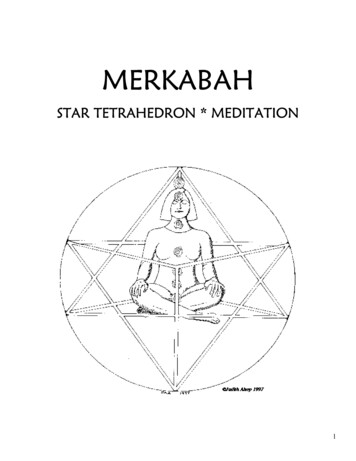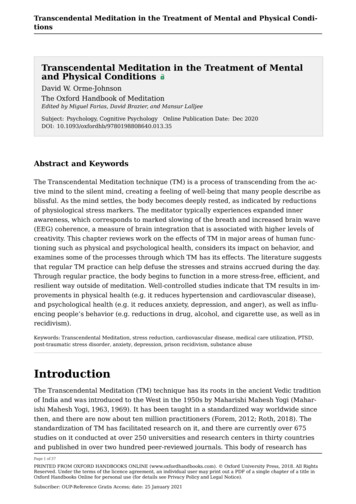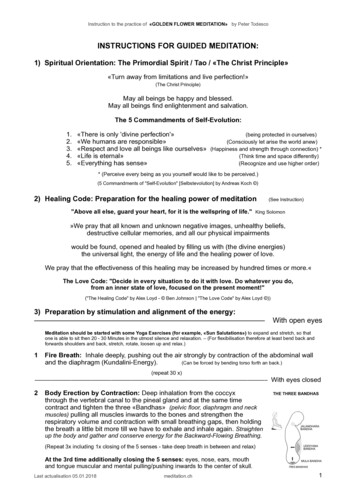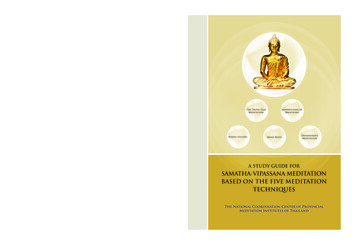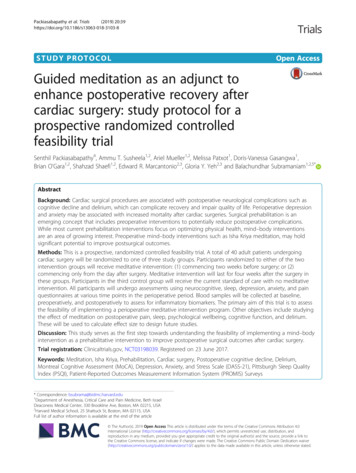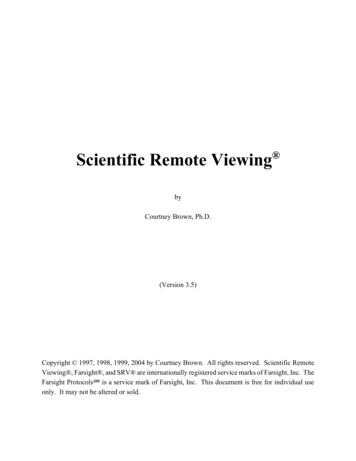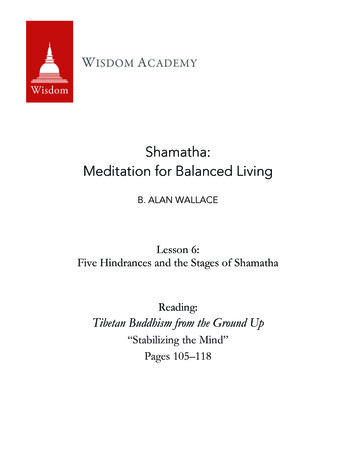
Transcription
W ISDOM A CADEMYShamatha:Meditation for Balanced LivingB. ALAN WALLACELesson 6:Five Hindrances and the Stages of ShamathaReading:Tibetan Buddhism from the Ground Up“Stabilizing the Mind”Pages 105–118
TIBETANBUDDHISMFROM THE GROUND UPA Practical Approachfor Modern LifeB. ALAN WALLACEwith STEVEN WILHELMWisdom Publications, Inc.—Not for Distribution
Wisdom Publications199 Elm StreetSomerville, MA 02144 USAwisdompubs.org 1993, 2016 B. Alan WallaceAll rights reserved.No part of this book may be reproduced in any form or by any means,electronic or mechanical, including photography, recording, or by anyinformation storage and retrieval system or technologies now known or laterdeveloped, without permission in writing from the publisher.Library of Congress Cataloging-in-Publication DataWallace, B. Alan.Tibetan Buddhism from the ground up : a practical approach formodern life / by B. Alan Wallace with Steven Wilhelm.—1st ed.p. cm.Includes bibliographical references and index.ISBN 0-86171-075-41. Buddhism. I. Wilhelm, Steven, 1948– . II. Title.BQ4132.W35 1992294.3’923—dc2093-15120ISBN 978-0-86171-075-1ebook ISBN 978-0-86171-790-319 18 17 169 8 7 6Cover design by TLrgggms. Interior designed by LZD.Set in Diacritical Garamond 12/14.5 and Mrs. Eaves.Wisdom Publications’ books are printed on acid-free paper and meet theguidelines for permanence and durability of the Production Guidelines for BookLongevity of the Council on Library Resources.Z This book was produced with environmental mindfulness.For more information, please visit wisdompubs.org/wisdom-environment.Printed in the United States of America.Please visit fscus.org.Wisdom Publications, Inc.—Not for Distribution
9Stabilizing the MindThe Purpose of Meditative QuiescenceSuppose that each of us wore a device that picked up all ourthoughts, even the most subtle, unintentional ones, and immediately blared them out through loudspeakers strapped to the tops ofour heads. As long as these thoughts remain hidden, often even fromourselves, we are able to present a fine semblance of sanity to thosearound us. But for most of us this veneer would swiftly vanish if others could hear the chaotic turbulence of our minds.The whole of spiritual practice can be seen as cultivation of deeperand deeper sanity. In Buddhism this path of making the mind sane isa gradual one, beginning with relatively easy practices that bring aboutobvious, tangible benefits. The first stage of practice is ethical discipline,discussed in the previous chapter. The direct, manifest result of a lifefocused on these ethical principles is a greater state of well-being forourselves and for those around us. Even without deep study or meditation, this brings about greater sanity and contentment.As a result of this foundation of spiritual practice, our thoughtswill be more wholesome, but our minds may still be scattered, unstable, and unclear. It is helpful to reinforce this foundation further bystabilizing our minds in meditation. In Buddhism the result of thispractice is called meditative quiescence, or tranquillity. One contemplative of the Kagyüpa order of Tibetan Buddhism sums up tranquillity practice as follows:Tranquillity is achieved by focusing the mind on anobject and maintaining it in that state until finally it ischanneled into one stream of attention and evenness.12105Wisdom Publications, Inc.—Not for Distribution
TibeTan buddhism From The Ground upThus, in the Buddhist context, meditative quiescence means morethan just a peaceful feeling. It is a quality of awareness that is stableand vivid, clearly focused upon its chosen object. It is not an end initself, but a fine tool to be employed in the third phase of traditionalBuddhist practice, namely, insight. The same author says of insightpractice:Insight is attained through a general and detailedexamination of reality and the systematic applicationof intellectual discrimination.13Experiential insight into the nature of reality is the direct antidoteto ignorance, the mental affliction that lies at the root of all distortions of the mind, unwholesome behavior, and suffering. However,without achieving meditative quiescence, the healing power of insightis limited, and ignorance cannot be fully dispelled.The Kagyüpa order, known for its emphasis on meditation, passeson such adages as “Where there is no contemplative tranquillity, thereis no insight,” and “If one seeks insight too early, one will not achievetranquillity.”14 This Tibetan approach is very much in accord with theearlier Buddhism of India, as evidenced by the comments of the greatIndian pandit Asaṅga regarding meditative quiescence and insight:What is tranquillity? It is to settle the mind in tranquillity, regularly, attentively, intensely; to clear the mind;to pacify the mind completely; and to settle the mindin one-pointedness and equipoise.What is insight? Insight is that which differentiatessystematically and fully all things. 15Certainly it is possible to gain some degree of insight without having achieved great mental stability, but such illumination is like thelight of a candle flickering in a breeze. This insight may be very meaningful, but due to the lack of meditative quiescence, it is fleeting, anddifficult for the meditator to experience repeatedly.106Wisdom Publications, Inc.—Not for Distribution
stabilizing the minDJust as it is possible to acquire a limited degree of insight withoutmeditative quiescence, so one may experience compassion to someextent without insight. But the most profound spiritual awakeningoccurs upon the foundation of all three—meditative quiescence,insight, and compassion—and it is for this purpose that one cultivatesmeditative quiescence.The Conditions for Meditative QuiescenceWe can begin to stabilize our minds from the beginning of our spiritual practice, while placing our chief emphasis on ethical discipline.By taking out some time each day for the practice of meditative quiescence, we become increasingly aware of how our minds function;and in the process we begin to discover how scattered our minds havebeen all along. Recognizing this, we may yearn to explore the potentials of the human mind that become apparent only when the awareness is still and lucid.Six conditions are necessary for the achievement of meditativequiescence. The first of these is a harmonious environment, one inwhich we feel secure, free from the dangers of war, pollution, contagious disease, and dangerous animals. Food and the other necessitiesshould be easily acquired, and the people with whom we associateshould be compatible. The cultivation of meditative quiescencerequires a quiet environment, free from the noises of conversationduring the day and such noises as the barking of dogs during thenight.The other five conditions are internal qualities. The first of theseis having few desires. This is an attitude of being undisturbed bywishes for things we do not have, be it a nicer dwelling, better food,better clothing, and the like.The third of the six conditions, contentment, complements thesecond. The attitude of contentment regards present circumstances,whatever they may be, with a sense of satisfaction. When we are107Wisdom Publications, Inc.—Not for Distribution
TibeTan buddhism From The Ground upcontented, we are concerned merely that the physical conditions forour practice are adequate. Once these are taken care of, we are free tofocus our attention on our meditation.The fourth condition of meditative quiescence is limiting ouractivities. When entering a contemplative retreat for the sake of stabilizing our minds, it is essential to reduce other activities to a bareminimum.The fifth condition may be the most important of all: pure ethical discipline. This does not mean one is so far advanced one neverengages in unwholesome behavior of body, speech, or mind. But itdoes mean that one is very familiar with the types of behavior toavoid, such as the ten unwholesome deeds; that one continuallytries to hold to the ethical principles described previously; and thatone takes steps to purify unwholesome actions once they have beencommitted.The sixth and final condition is the elimination of compulsive,discursive thinking about desires and other distractions. Many of usfind our minds inundated by a torrent of ideas throughout the day.This tendency must be curbed if we are ever to cultivate meditativequiescence. The point of Buddhist meditation is not to stop thinking,for, as we have seen, cultivation of insight clearly requires intelligentuse of thought and discrimination. What needs to be stopped is conceptualization that is compulsive, mechanical, and unintelligent, thatis, activity that is always fatiguing, usually pointless, and at times seriously harmful.It is not enough to learn a technique for stabilizing the mind andapply oneself to it with diligence. If these six underlying conditionsare not satisfied, meditative quiescence will never arise, regardlessof one’s determination or perseverance. This is what the renownedIndian sage Atiśa meant in his Lamp on the Path of Awakening:If the conditions for meditative quiescence are impaired,One may meditate intensively108Wisdom Publications, Inc.—Not for Distribution
stabilizing the minDFor as long as a thousand yearsWithout achieving tranquil absorption.Meditative Objects for Stabilizing the MindIn Buddhist practice we can choose among a wide variety of objectsfor stabilizing the mind. One common method in the TibetanBuddhist tradition is to focus on an image of the Buddha. First wetake a physical object, either a statue or painting of the Buddha,and gaze at it until we are very familiar with its appearance. Thenwe close our eyes and create a simulation of that image with ourimagination.The actual practice is not the visual one—this is only a preparation—for the point is to stabilize the mind, not the eyes. When we first tryto visualize the Buddha, the mental image is bound to be vague andextremely unstable. We may not even be able to get an image at all. Iremember teaching this technique many years ago to a group of students in the Swiss Alps. After we had been practicing together for ahalf hour or so, we took a break to discuss people’s initial experiences.One fellow raised his hand, and with some consternation confessedthat he was not able to see the Buddha in his mind’s eye at all. Forawhile his mind was blank; then finally the image of a sea gull flewthrough the space of his mind!While the above method has many benefits, it is not ideal foreveryone. For it to be effective, one must have a fairly peaceful mind,and it is helpful to have deep faith and reverence for the Buddha. Forpeople of a devotional nature, this practice can be very inspiring, andeffective at stabilizing the mind. One’s heart is stirred by bringingthe Buddha to mind with devotion, and consequently one’s enthusiasm for the meditation grows. On the other hand, if one has a veryagitated mind and little faith, this and other visualization techniquesmay very well lead to tension and unhappiness. And these problemsmay increase the more one practices.109Wisdom Publications, Inc.—Not for Distribution
TibeTan buddhism From The Ground upWith an agitated, conceptually congested mind, the sheer effort ofimagining a visualized object may be too taxing. So if one is engagingin visualization practices, especially during several sessions a day, it isimportant to be aware of one’s level of stress. It is important not tolet it get out of hand; for if it does, instead of stabilizing the mind thepractice will damage one’s nervous system.Another method that is practiced widely, especially in theBuddhist countries of east and southeast Asia, is focusing one’sawareness on the breath. A key attribute of this practice, as opposedto visualization of the Buddha, is that in breath awareness theobject of meditation, the breath, is present without our having toimagine it.Awareness of the breath is practiced in many different ways.Some people focus on the rise and fall of the abdomen during thein- and out-breath. Another technique is to focus on the tactile sensations, from the nostrils down to the abdomen, that are associatedwith the respiration. In yet another method one focuses on the sensations of the breath passing through the apertures of the nostrilsand above the upper lip. All of these are valuable methods, and theycan be especially useful for people with highly discursive, imaginative minds. They offer a soothing way to calm the conceptuallydisturbed mind.A third method of stabilizing the mind involves directing one’sawareness to the mind itself. This is the most subtle of all the techniques mentioned here, and its rewards are great. I shall elaborate onthis practice in a moment, but first I would like to discuss some of thethemes common to all methods of stabilizing the mind.Two facets of awareness are instrumental in all the aboveforms of meditative training. These are mindfulness and vigilance.Mindfulness is a mental factor that allows us to focus upon an objectwith continuity, without forgetting that object. So, if we are focusingon the sensations of our breath at our nostrils, mindfulness enablesus to fasten our attention there continuously. When mindfulness110Wisdom Publications, Inc.—Not for Distribution
stabilizing the minDvanishes, the mind slips off its object like a seal off a slick rock.Vigilance is another mental factor, whose function is to check up onthe quality of awareness itself. It checks to see if the meditating mindis becoming agitated and scattered, or dull and drowsy. It is the taskof vigilance to guard against these extremes.There are many inner hindrances to stabilizing the mind, but theyboil down to the two extremes of excitement and laxity. Excitementis a mental factor that draws our attention away from our intendedobject. This hindrance is a derivative of desire. If we are meditatingand suddenly find ourselves thinking about going to the refrigeratorand getting a snack, we can identify this impulse as excitement bornfrom desire. Excitement draws the mind outward. It can easily bestimulated by sound such as that of a car driving by. It compulsivelylatches onto the sound—a kind of mental hitchhiking—and elaborates on it with a series of images and thoughts.When the mind is not agitated, it is prone to slipping off to theother extreme of laxity. This mental factor does not distract theattention outward, but brings on a sinking sensation. The mindbecomes absorbed in its object without clarity, and drowsiness isbound to follow. At that point the object of the meditation is submerged under waves of lethargy or obliviousness.The chief antidotes to excitement and laxity are mindfulness andvigilance, and the results of overcoming those hindrances are mentalstability and clarity. These are the fruits of the practice.Meditative stability necessarily implies an underlying groundof relaxation and serenity. The mind is peaceful, and the attentionremains where we direct it for as long as we wish. Clarity refers moreto the vividness of subjective awareness than to the clarity of theobject. When it is present we can detect even the subtle and mostfleeting qualities of our object. For example, if we are visualizing theBuddha with clarity, he will appear in our mind’s eye in three dimensions and very lifelike. We will be able to see the color of his eyes,the individual folds in his robe. He will appear almost as clearly as if111Wisdom Publications, Inc.—Not for Distribution
TibeTan buddhism From The Ground upwe were seeing him directly with our eyes. Such subjective clarity isinstrumental in focusing on the breath as well as on the mind.All of us have experienced moments when our attention isextremely vivid. This may occur, for example, while driving a car ormotorcycle at high speed on a winding road, or when rock climbing.But when such mental clarity is experienced it is usually combinedwith a high degree of tension, and the mind is neither serene norstable. On the other hand, mental stability is a common experiencewhen we are pleasantly tired and we lie down to sleep. But in suchcases there is rarely much clarity of awareness.The challenge of meditative quiescence practice is to cultivatestability integrated with clarity, generating an extraordinarily usefulquality of awareness. To bring this about, experienced meditatorshave found that there must be a sequence of emphases in the practice.First seek a relaxed, wholesome, and cheerful state of mind. On thisbasis, emphasize stability, and then finally let clarity take priority. Theimportance of this sequence cannot be overemphasized.Focusing Awareness on the MindMany meditation teachers have made a common observation concerning Western meditators: We try so hard! Our efforts in meditation may be sporadic, but when we put our minds to it, we show truegrit. This attitude can create a lot of problems. For example, if weare trying to stabilize the mind through the practice of focusing on aBuddha image, the initial image is bound to be unclear and fleeting.At this stage, meditators are properly advised to be satisfied with avague object. It is best not to try harder to improve the quality of theimage; simply see if we can hold onto it without losing it.However strongly this may be emphasized, there is a powerfultendency, especially among Westerners, to try harder and harderto create a vivid object, and to hold it with sheer tenacity. Thissame attitude often prevails among those practicing awareness of112Wisdom Publications, Inc.—Not for Distribution
stabilizing the minDthe breath. Once again these serious meditators bear down on theobject, trying very hard to see it clearly and to hold onto it for dearlife. This, after all, is what we have been taught from childhood: “Ifyou want to get ahead, do your best. Try your hardest.” Our societyoften considers these two phrases to be synonymous.In meditation, however, they are not synonymous. Doing ourbest in this training does not mean to try our hardest; because, if weare trying our hardest, we are trying too hard. And if we try too hard,we will burn out; and our practice will be sporadic at best, until itfizzles out altogether. Doing our best in meditation means being asskillful as we can at finding the delicate balance between relaxationand exertion.An especially helpful tool for this is meditation on the mind itself.In this practice we have no clearly delineated, concrete object onwhich to focus. The mind has no form or location. If we try strenuously to focus our minds on it as our object, it eludes us. The tendency to overexert simply does not work here.To engage in meditation on the mind, one first finds a suitableposture. Much has been written on this subject, so I shall discuss onlysome of the major points. It is important to sit in an erect posture,with the spine straight. It is important not to become slouched forward or to tilt to the side or backward. Throughout the meditationsession one should keep the body still and relaxed.At the outset of this or any other Buddhist practice, it is helpful totake refuge. It is also vital to cultivate a good motivation, for this willprofoundly influence the nature of the practice. Finally, it is helpfulto be cheerful, cherishing this wonderful opportunity to explore thenature of consciousness.Although the main practice here is awareness of the mind, it isuseful to begin with a more tangible object to calm and refine one’sawareness. Breath awareness can be perfect for this. We should cultivate a general awareness of the breath coming in and going out.During inhalation, we should simply be aware that this is taking place.113Wisdom Publications, Inc.—Not for Distribution
TibeTan buddhism From The Ground upDuring exhalation, we note that the breath is going out. Awarenessis allowed to rest calmly in the present, while we breathe in a natural,unforced way.As we now move on to the main practice, we may follow thecounsel of Tilopa, the great Indian Buddhist contemplative: “Donot indulge in thought, but watch the natural awareness.”16 “Naturalawareness” has no shape or color, and it has no location. So how canwe focus on it? What does it mean “to watch” it?First of all, our task is to focus our attention on the mind, asopposed to the physical sense fields. One way to do this is to focus ourawareness initially on a mental event, such as a thought. This thoughtcould be anything—a word or a phrase—but it is helpful if it is onethat does not stimulate either desire or aversion.One possibility is the phrase: “What is the mind?” The point hereis not to speculate on this question, or to try to answer it. Rather,use that thought itself as the object of awareness. Very shortly afterhaving brought that phrase to mind, it is bound to fade out of ourconsciousness. At that point we keep our awareness right where it is.We have now directed our attention on the mind, and what remainsbetween the vanishing of one thought, and the arising of another, issimply awareness, empty and without obstruction, like space.An analogy may be helpful. Imagine yourself as a child lying onyour back, gazing up into a cloudless sky, and blowing soap bubblesthrough a plastic ring. As a bubble drifts up into the sky, you watch itrise, and this brings your attention into the sky. While you are looking at the bubble it pops, and you keep your attention right where thebubble had been. Your awareness now lies in empty space.In the actual meditation practice one focuses initially on the bubbleof a thought. When this thought vanishes one does not replace it withsome other mental construct. Rather, one stabilizes one’s attention innatural awareness, uncontrived, without conceptual elaboration.This practice is so subtle we may find we become tense in ourefforts to do it right. Some people even find the intensity of their114Wisdom Publications, Inc.—Not for Distribution
stabilizing the minDconcentration impedes their normal respiration—they restrict theirbreathing for fear it will disturb the delicate equilibrium of theirminds. Such tension and constricted respiration can only impair thepractice and our health in general. So it is crucial that we engage inthe meditation with a sense of physical and mental relaxation.Starting from relaxation one cultivates meditative stability, restingin natural awareness without being carried away by the turbulence ofthoughts or emotions. Finally, it is important to recognize that thispractice is not based upon a vague sort of trance or dull absorption;rather, it calls for vivid, clear awareness.To cultivate these three qualities of relaxation, stability, andclarity, it is usually helpful to keep the meditation sessions relativelyshort. The chief criterion for determining the length of one’s meditation sessions is the quality of one’s awareness during the practice. Fiveminutes of finely conducted meditation is worth more than an hourof low-grade conceptual chatter. Another useful criterion is one’sstate of mind following meditation. The mind should be refreshed,stable, and clear. If one feels exhausted and dull, one’s session wasprobably too long or of low quality.Phases of the PracticeOnce we have entered into this discipline, it may not be long beforewe experience short periods—perhaps up to ten seconds or longer—during which we are able to abide in a natural state of awareness,without grasping onto the thoughts and other events that arise in ourconsciousness. We may well find this delightfully exhilarating, andour minds may then leap upon the experience with glee. But as soonas our minds grasp in this way, the experience will fade. This can befrustrating.The remedy is to enter into this state of awareness repeatedly. Aswe become familiar with it, we can then take it in stride, withoutexpectation or anxiety. We learn to just let it be.115Wisdom Publications, Inc.—Not for Distribution
TibeTan buddhism From The Ground upAs the mind settles in this practice, our awareness of thoughtsand other mental events is also bound to change. At times we mayno longer sense ourselves thinking, yet a multitude of thoughts andimages may arise as simple events. One friend of mine told me thatwhile she was meditating in relative conceptual silence, the thoughtarose: “Pass the pizza, please.” She had not had a pizza for months,nor did she particularly want one at that moment. Thoughts willsimply arise, as will entire conversations. When this happens, justlet them be.Do not cling to these thoughts, identify with them, or try to sustain them. But also do not try to suppress them. Simply view themas spontaneous outflows of natural awareness, while centering yourattention on the pure, unelaborated awareness from which they arise.On many occasions we are bound to find ourselves carried awayby trains of thought. When we recognize this has happened, we mayreact with frustration, disappointment, or restlessness.All such responses are a waste of time. If we find our minds havebecome agitated, the antidote is to relax more deeply. Relax away theeffort that is going into sustaining our conceptual or emotional turbulence. It is best not to silence the mind with a crushing blow of ourwill. Instead, we may release the effort of grasping onto those mentalevents. Grasping arises from attachment, and the antidote is simply tolet go of this attachment.On other occasions we may experience mental laxity. Althoughthe mind is not agitated, it may rest in a nebulous blankness. Theantidote for this hindrance is to revitalize our awareness by payingcloser attention to the practice. The “middle path” here is to invigorate our awareness without agitating it.The great Indian Buddhist contemplative Saraha says of thispractice:By releasing the tension that binds the mind,One undoubtedly brings about inner freedom.17116Wisdom Publications, Inc.—Not for Distribution
stabilizing the minDTilopa speaks of three phases of the meditation. In the initialstages the onslaught of compulsive ideation is like a stream rushingthrough a narrow gorge. At this point it may seem that our mind ismore out of control, more conceptually turbulent, than it was beforewe began meditating. But in fact, we are only now realizing howmuch the mind normally gushes with semiconscious thoughts.As the mind becomes more quiescent, more stable, the streamof mental activity will become like the Ganges—a broad, quietlyflowing river. In the third phase of the practice, the continuum ofawareness is like the river flowing into the sea. It is at this point thatone recognizes the mind’s natural serenity, vividness, transparency,and freshness.During early stages of practice, we may experience moments ofmental quiescence relatively free of conceptualization, and we maywonder whether we are now ascertaining natural awareness. Mostlikely we are not. Our mind at this point is probably still too grossand unclear for such a realization. Patience is needed to persist inthe practice, without expectation or fear, until gradually the essential qualities of awareness become apparent. When we ascertain thesimple clarity and knowing qualities of the awareness, we are wellestablished in the practice. We can then proceed to the attainment ofmeditative quiescence focused on the mind.The Attainment of Meditative QuiescenceIn Buddhist practice the achievement of meditative quiescence isclearly defined. As a result of the practice outlined above, one eventually experiences natural awareness, and the duration of this experiencegradually increases. Eventually we no longer become distracted oragitated. At this point the emphasis of the practice should be on cultivating clarity. For the mind, even after it has become well stabilized,can still easily slip into laxity.117Wisdom Publications, Inc.—Not for Distribution
TibeTan buddhism From The Ground upWhen we finally attain meditative quiescence, we are free of eventhe subtle forms of excitement and laxity. During the early phases ofpractice, considerable degrees of effort are required, but as we progress, more and more subtle effort suffices. Gradually the meditationbecomes effortless, and we can sustain each session for hours on end.Benefits from this practice are also evident between formal meditation sessions. The mind becomes so refined and stable that it isvery difficult for mental distortions to arise. And even when theydo occur, they are relatively impotent and short-lived. Through theattainment of meditative quiescence, the mind is brought to such astate of heightened sanity it is very difficult for these afflictions tothrive. In addition, one will experience an unprecedented quality ofinner well-being that arises from the balance and health of the mind.Due to the shifts in the energies experienced in the body (closelyrelated to the nervous system), one will experience a delightful senseof physical lightness and buoyancy.The attainment of meditative quiescence is also said to be a fertilebasis from which to cultivate various types of heightened awarenesssuch as clairvoyance. When cultivated and employed with wisdomand compassion, these can be very useful. Otherwise, they are simply adistraction at best, and may be a real source of danger.In Buddhist practice the chief purpose of attaining meditativequiescence is to use this refined state of awareness for investigatingthe nature of reality. Meditative quiescence by itself is a temporary achievement that can easily be lost, especially if one becomesimmersed once again in a hectic, turbulent way of life. Only by usingthe mind that has been trained in meditative quiescence is it possibleto gain the depth of insight needed to utterly uproot the fundamentaldistortions of the mind, which are the root of suffering.In the meantime, the cultivation of meditative quiescence is something that brings us greater sanity, serenity, stability, and clarity. Thisis bound to aid us in all the pursuits worthy of our pre
Tibetan Buddhism from the ground up : a practical approach for modern life / by B. Alan Wallace with Steven Wilhelm.—1st ed. p. cm. Includes bibliographical references and index. ISBN 0-86171-075-4 1. Buddhism. I. Wilhelm, Steven, 1

